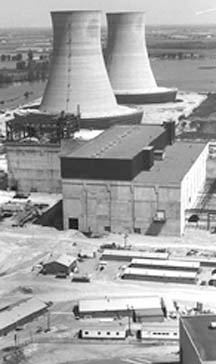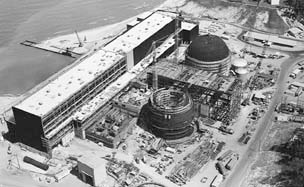Nuke plants an important source of energy, employment
Date Posted: November 23 2001
Michigan's nuclear power industry consists of three plants that supply a combined 14.1 percent of the electricity generated in Michigan.
The D.C. Cook, Fermi 2 and Palisades plants are a major source of electricity to the state - and over the last three decades, they have been a major source of employment to the building trades.
"Michigan's three plants are custom-designed, and they represent a real diversity of nuclear plant styles," said Pam Alloway-Mueller, spokeswoman for the Nuclear Regulatory Commission. "That's not unusual. The plants were built over a wide range of time, so they represent changes in technology and experience."
The plants cost billions of dollars to build, and they're continuing to provide the building trades with millions of dollars in maintenance outage man-hours. The Fermi 2 plant has regular refueling outages and other projects that employ hundreds of Hardhats. Some 600 building trades workers were on the Palisades site in 1998 when a large refueling outage took place. Nuclear plants require a lot of maintenance - and union trades workers are glad for it.
Following are summaries of Michigan's atom splitters, which make up an important part of the state's construction landscape:
D.C. Cook - Combined, the two reactors at the Donald C. Cook Nuclear Power Plant south of Berrien Springs are rated at 2,100 megawatts, making the plant the largest producer of nuclear power in Michigan.
Located on 650 acres along Lake Michigan, the plant was one of the largest construction projects ever in the state, employing up to 2,000 Hardhats. The construction permit was granted in 1969, and Unit 1 (1,020 megawatts) began commercial operation in August 1975. Unit 2 (1,090 megawatts) started up in July 1978. The construction cost for both units was $1.3 billion.
The American Electric Power Service Corporation served as architect and engineer for the project, which included pressurized water reactors. The nuclear steam supply system for both units were designed and built by Westinghouse Corporation. The turbine generators for Unit 1 and Unit 2 were purchased from General Electric Company and Brown Boveri Corporation respectively.
The plant is owned and operated by AEP.
Fermi 2 - With twin cooling towers rising 400 feet, the plant near Monroe certainly has the highest profile of Michigan's nuclear plants.
The cost to construct the plant was also big: an astonishing $5.1 billion. The plant was built between 1970-85, but there was a period from 1974-77 when no work was performed, because of Detroit Edison's "poor financial situation," the utility said at the time.
When work resumed, more than 1,600 construction workers were employed at Fermi 2. Hardhats placed 300,000 cubic yards of concrete, 20,000 tons of steel, 1,220 miles of electric cable and 70 miles of conduit.
Rated at 1,100 megawatts, the boiling water reactor plant is owner DTE Energy's largest single unit. The plant came on line in July 1985.
Palisades - Located on about 490 acres south of South Haven on the Lake Michigan shore, Consumers Energy's Palisades Nuclear Power plant began commercial generation of electricity on Dec. 31, 1971.
Construction on the 760 megawatt pressurized water reactor began in March 1967 by Bechtel Power Corporation. The plant cost $149 million, and today produces about 18 percent of Consumers Energy's total electric capacity - enough to light up three cities the size of Grand Rapids.
Water taken from Lake Michigan at a rate of 390,000 gallons per minute is used to cool the plant, using a fan-forced draft system.

SHOWN UNDER construction in 1977 with its massive cooling towers is the Fermi 2 Nuclear Power Plant near Monroe.

THIS IS the D.C. Cook plant south of Berrien Springs, shown in the early 1970s with its twin pressurized water reactors.

A MODERN photo of the Palisades plant, which employs rows of cooling fans to cool the pressurized water reactor plant.
